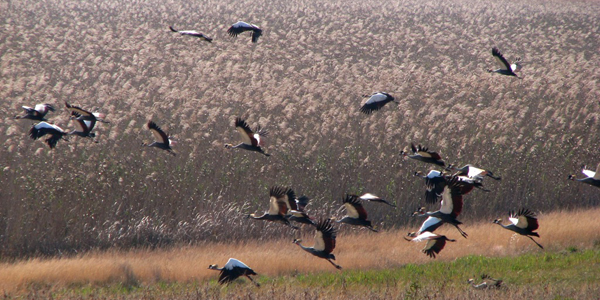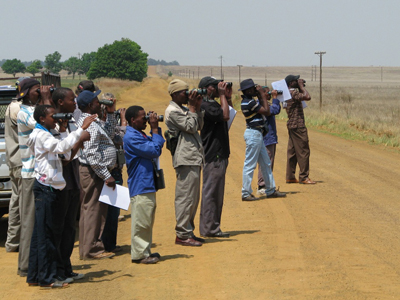
The Chrissiesmeer area in eastern South Africa is a key site for Grey Crowned Cranes, which use the area for flocking and breeding. Each July, local residents and EWT staff organize the Chrissiesmeer Crane Festival to celebrate the area’s cranes. Photo by Ursula Franke
By Ursula Franke, Senior Field Officer: Highveld Crane Conservation Project, ICF/EWT Partnership for African Cranes

A major milestone for the conservation of South Africa’s grasslands was reached on January 22, 2014 when 60,230 ha of South Africa’s Lakes District, Chrissiesmeer, was proclaimed as a Protected Environment! South Africa’s grasslands and wetlands are poorly represented in the country’s protected area network, and this declaration will therefore add significantly to the conservation of key habitat for all three of South Africa’s crane species – the Blue Crane, Grey Crowned Crane and Wattled Crane. This protection status, under the National Environmental Management: Protected Areas Act (57 of 2003), is a legal safeguard against unsustainable development in the area, while working towards the parallel objectives of economically-viable livestock production and tourism, water security, improved veld condition, and biodiversity conservation.
This momentous achievement was made possible through the collaborative efforts of the International Crane Foundation (ICF)/Endangered Wildlife Trust (EWT) partnership, Mpumalanga Tourism and Parks Agency (MTPA), the South African National Biodiversity Institute, and World and BirdLife South Africa. It is the result of long and fruitful partnerships that began as long ago as 2006 and formed part of MTPA’s provincial Biodiversity Stewardship Program.
One of the key objectives in the ICF/EWT Africa Program is to secure (if at all possible, legally) areas important to cranes, in collaboration with local communities and other relevant stakeholders – i.e. local communities still have use of the land for their livelihoods, but in a way that ensures the ecological integrity of the site. Although we are currently working at a number of sites across Africa, Chrissiesmeer is the first (and biggest) area that we have now obtained security for.
The Chrissiesmeer Lakes District is a proposed Ramsar site (Wetlands of International Importance) and provides critical habitat for numerous threatened species. These range from South Africa’s National Bird, the Blue Crane, to African Grass Owls and the inconspicuous Golden Mole. An entirely new freshwater crab species, apparently preferring peat wetlands, has also recently been discovered in Chrissiesmeer and at Lakenvlei, another proposed Protected Environment in Mpumalanga province. Formally conserving these critical habitat areas, which are all under immense pressure from unsustainable development, are therefore of great importance both for the charismatic species we know of as well as for unknown species that are being discovered in areas that are thought of as well studied.
In partnership with MTPA and with funding from the World Wildlife Fund Nedbank Green Trust and Millstream, the ICF/EWT partnership spearheaded land owner engagements in Chrissiesmeer, which has now finally culminated in the declaration of the Chrissiesmeer Protected Environment. We are excited about this conservation milestone especially in the light of the development pressures the area faces. We would also like to extend our appreciation to our partners, especially Brian Morris from MTPA for his hard work to reach this point, and to the Honorable MEC Mrs YN Phosa (Member of the Executive Council of Mpumalanga province) for her visionary commitment to biodiversity conservation in Mpumalanga.
For Chrissiesmeer this is only Phase 1, and once the management plan is completed and being implemented by the 60 land owners currently involved, Phase 2 will commence where we aim to include the remaining 20,000 ha so that the entire Chrissiesmeer catchment can be formally protected. Only then can we apply for Ramsar status.
But for now join us, our partners, and the land owners in the celebrations for which we have worked so long and hard. This is indeed a momentous milestone for crane conservation in South Africa.
